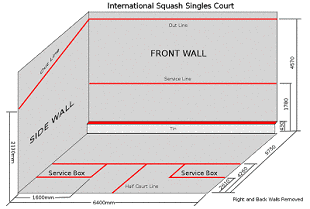SQUASH RULES UK: Check out the match winning tactics of the fast-moving indoor court game.
All the rudimentary and basic squash rules for beginners get listed below. Newcomers and novices will this simple guide an easy-to-follow overview.
The popular racket sport was originally known as ‘Squash Racquets‘ game. It first began in the 19th century with its birthplace credited to the Harrow School in London.
UK Squash & Racketball in Manchester currently regulate the rules for squash in the modern game.
The official rule book gets approved and overseen by the World Squash Federation. The WSF Official Rule Book is also available with a PFD download option.
A competitive squash game requires skill and a quick turn of speed. Not to mention oodles of agility and supreme fitness.
For Example: Squash ball speeds can reach 170mph. The most energetic of players often burn off around 1000 calories an hour.
Squash Rules and Regulations
Aim of Playing Squash Game
There is one basic principle of squash game rules. That is to continue hitting the squash ball against the front wall until your opponent fails to return it to you.
Match warm-ups take place immediately preceding the start of play – usually in the court. But, the warming-up periods should not exceed five minutes.
The Basic Rules for Squash Equipment
Each player (two in total) will use their own squash racket. Rackets are usually made of composite material such as graphite or Kevlar. They will play using one rubber ball (unless it bursts and needs replacing).
The ball speed characteristics and colouring differs according to player standard:
- Double Yellow: Extra super slow [competition standard]
- Yellow: Super slow
- Green or White: Slow
- Red: Medium
- Blue: Fast

Squash Serve Rules
- Spinning – and winning – the racket or a coin toss determines the initial right to serve. Afterwards, the server continues to serve until the opponent wins the point. The opponent will then become the server.
- Squash service rules give the server a choice of serving from either service box at the start of each game and each rally. You should alternate thereafter for as long as you score points and remain the server.
- Players must keep one foot in the service box as they serve the ball.
- Serve the ball directly on to the front wall between the service line and the ‘out‘ line. A as it returns, unless volleyed, its first bounce should land within the back quarter of the court opposite to the server’s box.
- Players must hit the wall above the board and below the ‘out‘ line for the remainder of the rally.
- A Service Fault happens if:
- At the time of striking the ball the server fails to have at least one foot in contact with the floor within the service box, and no part of that foot touching the line surrounding the service box (called a foot-fault ).
- After releasing the ball the server fails to strike it before the ball falls to the floor, touches a wall, or touches anything the server wears.
- The server fails to strike the ball directly onto the front wall between the service and the ‘out‘ lines.
- Unless volleyed by the receiver, the first bounce of the ball on the floor is not in the quarter court opposite the serves box.
- The server serves the ball out.
Squash Rules for ‘Let’ Regulation
- A ‘let‘ is an undecided or undetermined stroke. During ‘lets‘, the service or rally does not count. Thus, the server should repeat the serve from the same box.
- A let may be part of play if:
- The striker refrains from hitting the ball owing to a reasonable fear of injuring the opponent.
- The striker, on the way to playing the ball incurs sufficient interference to impede their access to the ball when the striker would have otherwise played a good shot.
- The Referee gets asked to decide an appeal and is unable to do so.
- A Let must be part of play if:
- The Receiver is not ready and does not attempt to take the service.
- The ball breaks during play.
- An otherwise good return gets made, but the ball goes out on its first bounce.
- The ball in play touches the receiver or anything carried or worn by the receiver whilst on the way to the side wall or back wall in anticipation that the ball would have reached the front wall and hence been a good return.
Basic Squash Rules in General Play
- Players return the ball – following a good service – alternating strokes until one player fails to make a good return or the ball ceases to be in play. This must get carried out under the squash rules and regulations.
- The ball is only allowed to hit the floor once before each shot, but it can hit as many walls as the player wants.
- If any part of the ball touches the ‘out’ line the ball gets deemed out. Or, if the ball hits the tin or the floor on its second bounce the ball is also deemed to be down.
- Similarly, if the ball bounces on or before the short line from a service, the serve gets deemed to be a fault.
- Thus, a return stroke is good if the ball, before it has bounced twice on the floor, gets returned by the striker on to the front wall above the tin. This should happen without touching the floor or any part of the striker’s body or clothing, provided the ball is not hit twice, down or out. A player can also lose a rally if the ball hits them or their clothing before they strike the ball.
- Freedom to play the ball means a player must make every effort:
- To get out of the opponents way after playing a ball:
- To give the opponent a fair view of the ball, so that it may get sighted adequately to play it.
- Not to interfere with, or crowd, the opponent in the latter’s attempt to get to, or play, the ball.
- To allow the opponent, as far as the latter’s position permits, freedom to play the ball directly to the front wall, or to either side wall.
Scoring Rules in Squash
Squash scoring rules allow matches to get played to the best of either 3 or 5 games. The number of games is usually determined by the competition organizer.
In the British system, if the player receiving the serve wins a rally, the score does not change. But, he or she becomes the server (i.e. you can only score points when you are serving).
A player must reach nine points to win a game and by 2 clear points if the game score gets tied at 10-10.
Game Points and Strokes:
According to the basic rules of squash a player wins a stroke if:
- The server fails to make a good service.
- The opponent fails to make a good return of the ball in play.
- The ball in play touches the opponent or anything carried or worn by the opponent whilst on the way to the front wall.
- A player drops the racket, calls out or in any other way distracts the opponent. The same applies if the referee considers that such occurrence has caused the opponent to lose the stroke.
- The ball hits the ceiling or any object outside of the court.

Basic Rules of Squash Tactics
Try to make your opponent do the majority of the running. Dominating the ‘T‘ area (where the middle line intersects the front line) is one of the best ways to win a game of squash.
Your opponent has less chance of reaching the ball if you keep your shots low. The back two corners are the most important areas on a squash court.
Winning a Game of Squash
You win the game when you reach the required amounts of sets. Players should agree the number of sets before the start of the match. The majority of squash games play to the best of 5 games. So, the first player to reach that number would be the winner.
Advanced UK Squash Rules for Beginners
Start Playing Squash
Squash games are hugely popular in the United Kingdom. Thousands of sports clubs entertain players and fans across the country. The basic squash equipment you need is not too expensive.
Even youngsters are learning how to play the game in their version called Mini Squash. You need a pair of indoor trainers, a squash racket, and a ball. Then you can get yourself booked on a local court and find out how easy it is to start playing squash.
ALSO IN THIS SECTION
A to Z Sports Rules and Regulations: A list of popular indoor and outdoor sport categories.
Badminton Rules: All the BWF official rules and regulations in badminton game.
Dodgeball Rules: Check out the rules and regulations of dodgeball.
Team Handball: Fast-paced indoor game of passing and dribbling a ball with your hands.
Weird Sports Rules: A concise list of weird and wonderful sports games around the world.
WSF Squash Rules PDF: [Free Download Option]

